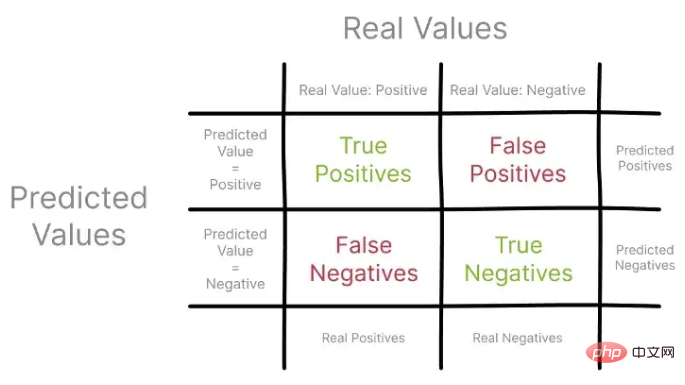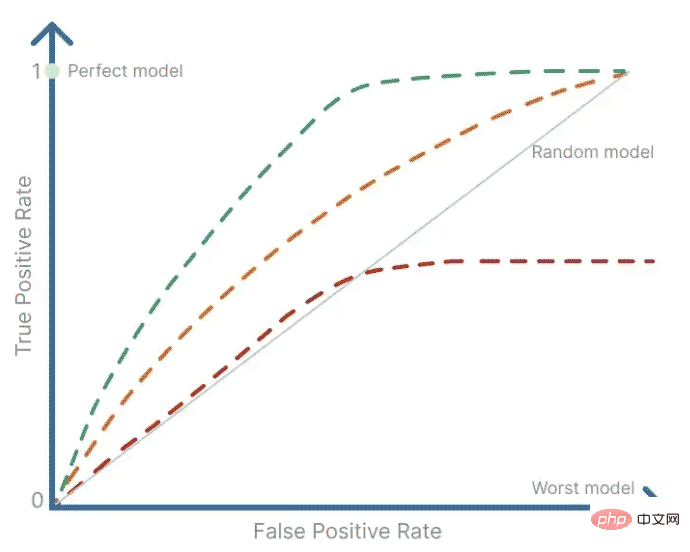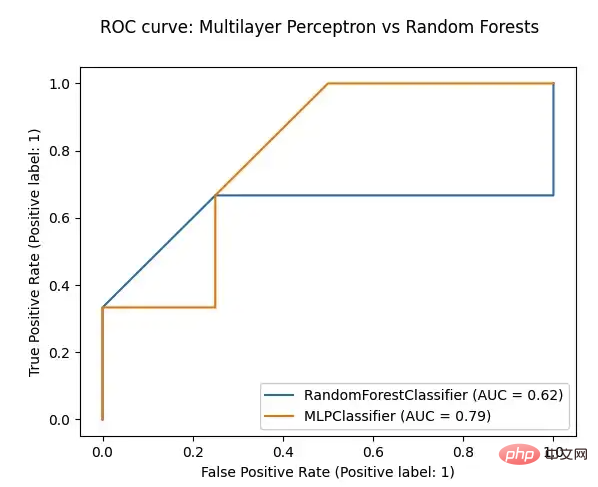What are python model performance ROC and AUC
Text
ROC Analysis and area under the curve (AUC) are widely used tools in data science, borrowed from signal processing, to evaluate the quality of models under different parameterizations, Or compare the performance of two or more models.
Traditional performance metrics, such as precision and recall, rely heavily on the observation of positive samples. Therefore, ROC and AUC evaluate quality using true positive and false positive rates, taking into account both positive and negative observations.
There are multiple steps in the process from decomposing a problem to using machine learning to solve it. It involves data collection, cleaning and feature engineering, building the model, and finally, evaluating the model performance.
When you evaluate the quality of a model, you typically use metrics such as precision and recall, also known as confidence and sensitivity, respectively, in the field of data mining.
These metrics compare predicted values to actual observations, usually from a holdout set, visualized using a confusion matrix.

Let’s first focus on accuracy, also known as positive predictive value. Using a confusion matrix, you can construct Precision as the ratio of all true positives to all predicted positives.

Recall, also known as true positive rate, represents the ratio of true positives to all observed and predicted positives.

Using different sets of observations in a confusion matrix to describe Precision and Recall, you can start to understand how these metrics inform the model Performance view.
It is worth noting that Precision and Recall only focus on positive examples and predictions, without considering any negative examples. Furthermore, they do not compare the model's performance to the median scenario, which is just a random guess.
1. ROC Curve
ROC is a summary tool used to visualize the trade-off between Precision and Recall. ROC analysis uses an ROC curve to determine how much of a binary signal's value is contaminated by noise, i.e., randomness. It provides a summary of sensitivity and specificity for a continuous predictor over a range of operating points. The ROC curve is obtained by plotting the false positive rate on the x-axis against the true positive rate on the y-axis.
Because the true positive rate is the probability of detecting a signal, and the false positive rate is the probability of a false positive, ROC analysis is also widely used in medical research to determine the threshold that reliably detects disease or other behavior.

A perfect model would have a false positive rate and a true positive rate equal to 1, so it would be the single operating point in the upper left corner of the ROC plot. And the worst possible model will have a single operating point in the lower left corner of the ROC plot where the false positive rate equals 1 and the true positive rate equals 0.
The random guessing model has a 50% chance of correctly predicting the outcome, so the false positive rate will always equal the true positive rate. This is why there is a diagonal line in the graph, which represents a 50/50 probability of detecting signal versus noise.
2. AUC Area
To fully analyze the ROC curve and compare the performance of the model with several other models, you actually need to calculate the area under the curve (AUC), also in the literature is called the c statistic. The area under the curve (AUC) has a value between 0 and 1 because the curve is plotted on a 1x1 grid and parallel to signal theory, it is a measure of signal detectability.
This is a very useful statistic as it gives us an idea of how well the model ranks real observations versus false observations. It is actually a normalized version of the Wilcoxon-Mann-Whitney rank sum test, which tests the null hypothesis where two ordered measurement samples are drawn from a single distribution.
To plot a ROC curve and calculate the area under the curve (AUC), you decide to use SckitLearn's RocCurveDisplay method and compare a multilayer perceptron to a random forest model in an attempt to solve the same classification task.
import matplotlib.pyplot as plt
from sklearn.ensemble import RandomForestClassifier
from sklearn.metrics import roc_auc_score, RocCurveDisplay
def plot_roc(model, test_features, test_targets):
"""
Plotting the ROC curve for a given Model and the ROC curve for a Random Forests Models
"""
# comparing the given model with a Random Forests model
random_forests_model = RandomForestClassifier(random_state=42)
random_forests_model.fit(train_features, train_targets)
rfc_disp = RocCurveDisplay.from_estimator(random_forests_model, test_features, test_targets)
model_disp = RocCurveDisplay.from_estimator(model, test_features, test_targets, ax=rfc_disp.ax_)
model_disp.figure_.suptitle("ROC curve: Multilayer Perceptron vs Random Forests")
plt.show()
# using perceptron model as input
plot_roc(ml_percetron_model, test_features, test_targets)
The above is the detailed content of What are python model performance ROC and AUC. For more information, please follow other related articles on the PHP Chinese website!

Hot AI Tools

Undresser.AI Undress
AI-powered app for creating realistic nude photos

AI Clothes Remover
Online AI tool for removing clothes from photos.

Undress AI Tool
Undress images for free

Clothoff.io
AI clothes remover

Video Face Swap
Swap faces in any video effortlessly with our completely free AI face swap tool!

Hot Article

Hot Tools

Notepad++7.3.1
Easy-to-use and free code editor

SublimeText3 Chinese version
Chinese version, very easy to use

Zend Studio 13.0.1
Powerful PHP integrated development environment

Dreamweaver CS6
Visual web development tools

SublimeText3 Mac version
God-level code editing software (SublimeText3)

Hot Topics
 1387
1387
 52
52
 Is the vscode extension malicious?
Apr 15, 2025 pm 07:57 PM
Is the vscode extension malicious?
Apr 15, 2025 pm 07:57 PM
VS Code extensions pose malicious risks, such as hiding malicious code, exploiting vulnerabilities, and masturbating as legitimate extensions. Methods to identify malicious extensions include: checking publishers, reading comments, checking code, and installing with caution. Security measures also include: security awareness, good habits, regular updates and antivirus software.
 Can vs code run in Windows 8
Apr 15, 2025 pm 07:24 PM
Can vs code run in Windows 8
Apr 15, 2025 pm 07:24 PM
VS Code can run on Windows 8, but the experience may not be great. First make sure the system has been updated to the latest patch, then download the VS Code installation package that matches the system architecture and install it as prompted. After installation, be aware that some extensions may be incompatible with Windows 8 and need to look for alternative extensions or use newer Windows systems in a virtual machine. Install the necessary extensions to check whether they work properly. Although VS Code is feasible on Windows 8, it is recommended to upgrade to a newer Windows system for a better development experience and security.
 How to run programs in terminal vscode
Apr 15, 2025 pm 06:42 PM
How to run programs in terminal vscode
Apr 15, 2025 pm 06:42 PM
In VS Code, you can run the program in the terminal through the following steps: Prepare the code and open the integrated terminal to ensure that the code directory is consistent with the terminal working directory. Select the run command according to the programming language (such as Python's python your_file_name.py) to check whether it runs successfully and resolve errors. Use the debugger to improve debugging efficiency.
 Can visual studio code be used in python
Apr 15, 2025 pm 08:18 PM
Can visual studio code be used in python
Apr 15, 2025 pm 08:18 PM
VS Code can be used to write Python and provides many features that make it an ideal tool for developing Python applications. It allows users to: install Python extensions to get functions such as code completion, syntax highlighting, and debugging. Use the debugger to track code step by step, find and fix errors. Integrate Git for version control. Use code formatting tools to maintain code consistency. Use the Linting tool to spot potential problems ahead of time.
 Choosing Between PHP and Python: A Guide
Apr 18, 2025 am 12:24 AM
Choosing Between PHP and Python: A Guide
Apr 18, 2025 am 12:24 AM
PHP is suitable for web development and rapid prototyping, and Python is suitable for data science and machine learning. 1.PHP is used for dynamic web development, with simple syntax and suitable for rapid development. 2. Python has concise syntax, is suitable for multiple fields, and has a strong library ecosystem.
 Can vscode be used for mac
Apr 15, 2025 pm 07:36 PM
Can vscode be used for mac
Apr 15, 2025 pm 07:36 PM
VS Code is available on Mac. It has powerful extensions, Git integration, terminal and debugger, and also offers a wealth of setup options. However, for particularly large projects or highly professional development, VS Code may have performance or functional limitations.
 Can visual studio code run python
Apr 15, 2025 pm 08:00 PM
Can visual studio code run python
Apr 15, 2025 pm 08:00 PM
VS Code not only can run Python, but also provides powerful functions, including: automatically identifying Python files after installing Python extensions, providing functions such as code completion, syntax highlighting, and debugging. Relying on the installed Python environment, extensions act as bridge connection editing and Python environment. The debugging functions include setting breakpoints, step-by-step debugging, viewing variable values, and improving debugging efficiency. The integrated terminal supports running complex commands such as unit testing and package management. Supports extended configuration and enhances features such as code formatting, analysis and version control.
 Golang vs. Python: Concurrency and Multithreading
Apr 17, 2025 am 12:20 AM
Golang vs. Python: Concurrency and Multithreading
Apr 17, 2025 am 12:20 AM
Golang is more suitable for high concurrency tasks, while Python has more advantages in flexibility. 1.Golang efficiently handles concurrency through goroutine and channel. 2. Python relies on threading and asyncio, which is affected by GIL, but provides multiple concurrency methods. The choice should be based on specific needs.




